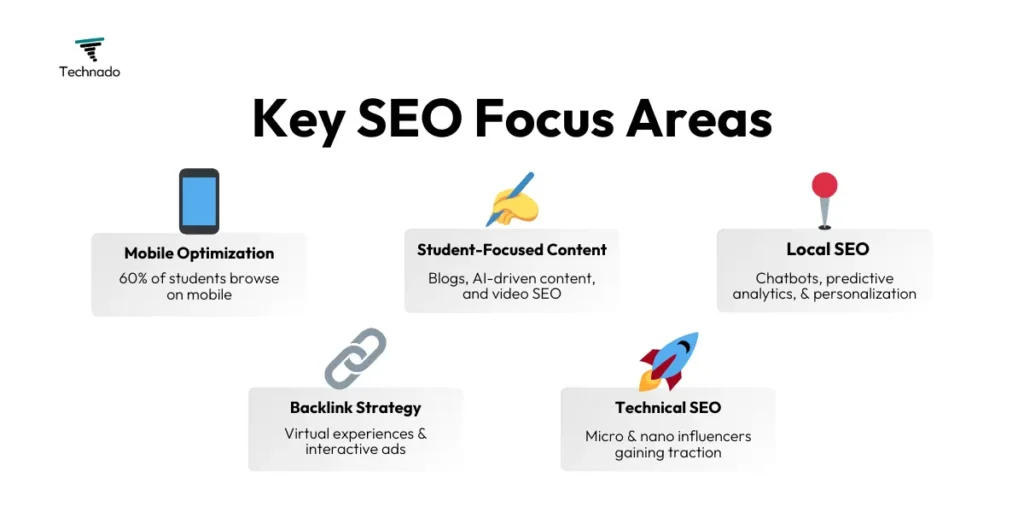In the digital age, universities and colleges can no longer rely solely on traditional marketing methods like print brochures, TV ads, and campus fairs to attract students. Today, most prospective students turn to search engines to research programs, financial aid, admission requirements, and campus life before making their enrollment decisions. If an institution’s website is not optimized for search engines, it risks being overshadowed by competitors with stronger online visibility.
Search Engine Optimization (SEO) is a critical component of any university’s digital strategy. A well-executed SEO plan ensures that an institution ranks prominently in search results, attracts qualified applicants, and strengthens its reputation as a leading educational institution. This guide explores effective SEO strategies tailored specifically for higher education, covering keyword research, content marketing, technical SEO, local optimization, and link-building techniques. By implementing these strategies, universities and colleges can enhance their online presence, drive more website traffic, and increase student enrollment.
Why SEO Matters for Universities & Colleges
- The Shift in Student Search Behavior
Today’s students rely heavily on search engines when making education-related decisions. Studies show that nearly 93% of all online experiences begin with a search engine, and over 75% of users never scroll past the first page of search results. If a university’s website does not appear in top search rankings for relevant queries like “best business schools in the US” or “affordable online MBA programs,” potential students may never find it.
- Increased Website Traffic and Brand Awareness
SEO helps universities enhance their visibility by ensuring their website ranks for the right keywords. This increased visibility translates into more traffic, helping institutions engage prospective students, faculty members, researchers, and even donors.
- Higher Enrollment and Admissions
Prospective students frequently search for degree programs, scholarships, and campus facilities online. A strong SEO strategy ensures that a university’s website appears in search results when students look for specific courses, making it easier for them to explore programs and apply.
- Building Credibility and Trust
High search rankings enhance an institution’s credibility. Universities that consistently appear at the top of search results are perceived as more reputable, encouraging more applications and faculty interest. Additionally, a well-structured SEO strategy can help institutions manage their online reputation, ensuring that positive news articles, faculty research, and alumni success stories are prominently displayed.
- Attracting Both Local and International Students
SEO can help universities target both local and international students. By optimizing for location-based searches and multilingual content, institutions can appeal to a global audience, expanding their reach beyond national borders.
- Long-Term, Cost-Effective Marketing Strategy
Unlike paid advertising campaigns, SEO provides long-term benefits. Once a university’s content ranks well on search engines, it continues to attract organic traffic without requiring continuous investment. This makes SEO a highly cost-effective marketing strategy compared to traditional advertising or pay-per-click (PPC) campaigns.

Key SEO Strategies for Universities & Colleges
1. Keyword Research: Understanding Student Search Intent
Keyword research is the foundation of any successful SEO strategy. Universities must identify the terms and phrases prospective students, parents, and faculty members use when searching for programs and admissions information.
Types of Keywords Universities Should Target
- Branded Keywords – Searches that include the university’s name, such as “Harvard Business School admissions” or “Stanford University scholarships.”
- Program-Specific Keywords – Queries related to specific academic programs, such as “best online computer science degree” or “top law schools in the UK.”
- Location-Based Keywords – Searches that specify geographic areas, such as “best universities in California” or “top colleges in London.”
- Long-Tail Keywords – More detailed, question-based queries, such as “What are the admission requirements for an MBA in Canada?”
- Competitor Keywords – Keywords for which other universities rank well. Analyzing these keywords can help institutions optimize their content accordingly.
Using tools like Google Keyword Planner, Ahrefs, SEMrush, and Ubersuggest, universities can identify high-traffic, low-competition keywords to optimize their content.
2. On-Page SEO Optimization
On-page SEO involves optimizing website content and structure to improve rankings.
Title Tags and Meta Descriptions
- Titles should be concise, keyword-rich, and under 60 characters (e.g., “Top Computer Science Programs – Apply Now | XYZ University”).
- Meta descriptions should provide a brief summary of the page in 160 characters or less and include relevant keywords.
URL Structure
- URLs should be simple and descriptive, such as university.edu/online-mba instead of university.edu/xyz123/?p=9876.
Header Tags (H1, H2, H3, etc.)
- Use H1 tags for main titles, H2 for subheadings, and H3 for subsections to improve readability and structure.
Internal Linking
- Link to important pages such as admissions, scholarships, and faculty profiles to improve navigation and distribute SEO value across the website.
3. Content Marketing: Creating High-Quality, Engaging Content
Content is one of the most effective ways to improve SEO rankings and attract prospective students. Universities should consistently publish informative, engaging, and relevant content.
Types of Content Universities Should Publish
- Blog Posts and Articles – Cover topics like career prospects, faculty research insights, and application tips (e.g., “5 Reasons to Study Data Science in 2025”).
- Student Testimonials and Alumni Success Stories – Showcase real student experiences to build trust and credibility.
- Virtual Campus Tours and Video Content – Use videos to highlight campus life, faculty interviews, and program overviews.
- FAQs and Informational Guides – Address common student queries such as “How to Apply for a Student Visa?” or “Best Scholarships for International Students.”
Content should be structured to target featured snippets in Google search results, which increase visibility and drive more traffic.
4. Technical SEO: Enhancing Website Performance
Technical SEO ensures that search engines can efficiently crawl, index, and rank a university’s website.
Key Technical SEO Factors:
- Mobile Optimization – Websites must be fully responsive, as over 60% of students search on mobile devices.
- Page Speed Optimization – Faster load times improve user experience and rankings. Use Google PageSpeed Insights to identify issues.
- Secure Website (HTTPS) – SSL encryption is essential for both security and search rankings.
- XML Sitemaps and Robots.txt – These files help search engines understand site structure and improve indexing.
5. Local SEO: Attracting Regional and International Students
Local SEO helps universities rank for searches within specific geographic locations.
Strategies for Local SEO Optimization:
- Google My Business (GMB) Optimization – Universities should maintain a complete and updated Google My Business profile with accurate contact details, photos, and student reviews.
- NAP (Name, Address, Phone Number) Consistency – Ensure consistent information across directories like Google, Yelp, and university listings.
- Localized Content – Create blog posts and pages targeting specific regions, such as “Best Universities in Canada for Indian Students.”
6. Link Building: Establishing Authority with High-Quality Backlinks
Backlinks from authoritative sources help universities build credibility and improve rankings.
Effective Link-Building Strategies:
- Academic Citations and Research Publications
- Guest Blogging on Education Portals
- Partnerships with Other Universities and Industry Leaders
Universities can also engage with alumni networks to gain natural backlinks from alumni websites and career portals.
Conclusion
SEO is an essential strategy for universities and colleges looking to enhance their online presence, attract prospective students, and improve enrollment rates. By focusing on keyword research, on-page optimization, content marketing, technical SEO, local SEO, and link building, institutions can ensure that they rank higher in search results and remain competitive in the digital education landscape.
With search engine algorithms continuously evolving, universities must stay proactive in refining their SEO strategies. Investing in a comprehensive SEO approach today will yield long-term benefits, ensuring sustained visibility, credibility, and student engagement. By implementing these best practices, universities can position themselves as top choices for students worldwide.
Suggested Reads
DigitalOcean Expands to Pakistan – New HQ at COLABS
Manus Isn’t China’s Second ‘DeepSeek Moment’—Here’s Why
Google Pay Launches in Pakistan: A Game Changer for Digital Payments

Burhan Ahmad is a Senior Content Editor at Technado, with a strong focus on tech, software development, cybersecurity, and digital marketing. He has previously contributed to leading digital platforms, delivering insightful content in these areas.








